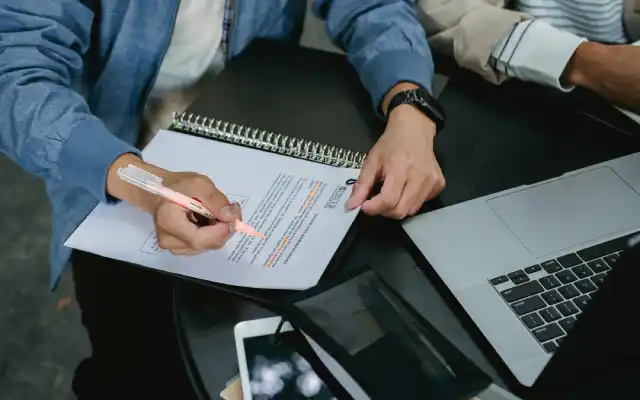Salah satu materi ujian Bahasa Inggris yang sering muncul adalah direct indirect speech. Belajar direct indirect speech digunakan untuk melaporkan sebuah pesan yang disampaikan oleh seseorang, dengan isi pesan sama persis seperti yang diutarakan orang tersebut, seperti contoh: Budi said “Thank you for your present.” Sebaliknya, indirect speech digunakan untuk menyampaikan pesan orang lain menggunakan bahasa kita sendiri.
Topik Pembahasan
Aturan Penggunaan Direct Indirect Speech
Untuk merubah sebuah kalimat bentuk direct speech ke indirect speech, ada beberapa faktor yang harus dipertimbangkan. Selain verb, kamu juga harus memperhatikan modal, place, time, tense, pronoun, dan lainnya. Berikut adalah panduan belajar Direct Indirect speech serta aturan penggunaannya:
Penggunaan Verb
Ketika verb dalam direct speech adalah past tense, maka semua present tense dalam indirect speech harus dirubah pada bentuk past, seperti contoh berikut:
- Budi said, “I am wrong”. (Direct speech)
- Budi said that he was wrong (Indirect speech)
Dalam indirect speech, tenses tidak akan berubah kalau kata yang ada dalam tanda petik berbicara tentang habitual action atau universal truth, berikut contohnya:
- Joko said, “we cannot live without Oxygen”. (Direct)
- Joko said that we cannot live without Oxygen. (Indirect)
Tenses pada direct speech tidak akan berubah jika reporting verb menggunakan bentuk future tense atau present tense, seperti contoh berikut:
- Nadine says/will say, “I am waiting.” (Direct)
- Nadine says/will say she is waiting. (Indirect)
Merubah Direct Speech ke Indirect Speech – Present Tense
Direct Speech dalam bentuk present perfect, harus diubah menjadi past perfect dalam Indirect Speech, seperti contoh berikut:
- “I have been to Yogyakarta”, he told me (Direct speech)
- He told me that he had been to Yogyakarta (Indirect Speech).
1. Merubah Present Continuous ke Past Continuous
- She said, “He has completed his task”. (Direct)
- She said that he had completed his task (Indirect)
2. Merubah Simple Present ke Simple Past
- “I am sick”, he said (Direct)
- He said that he was sick. (Indirect)
Cara Merubah Direct Speech ke Indirect Speech – Past dan Future Tense
Merubah Direct Speech simple past ke Indirect speech Past Perfect, adalah berikut:
- He said, “Delina left on Friday.” (Direct)
- He said that Delina had left on Friday. (Indirect Speech)
1. Past Continuous menjadi Past Perfect Continuous
- “They were watching a movie”, He told me. (Direct)
- He told me that they had been watching a movie. (Indirect)
2. Future ke Present Conditional
- He said, “They will be in Magelang tomorrow.” (Direct)
- He said that they would be in Magelang the next day (Indirect)
3. Future Continuous to Conditional Continuous
- Joe said, “We’ll be leaving this city next Monday,” (Direct)
- Joe said that we would be leaving this city the following Monday.
Agar dapat menguasai direct indirect speech secara lisan, sangat penting untuk memiliki pengetahuan konseptual yang jelas tentang materi tersebut. Kamu juga harus menguasai penggunaan dan aturan materi ini dalam Bahasa Inggris.
Merubah dalam Bentuk Interrogative
Tidak perlu menggunakan conjunction jika sebuah kalimat direct speech dimulai dengan sebuah pertanyaan (what/where/when) karena ‘question-words’ adalah joining clause, berikut contohnya:
- “Where do you go?” asked my father (Direct)
- My father enquired where I went. (Indirect)
Jika direct speech dalam kalimat dimulai dengan helping verb atau auxiliary verb, joining clause harus menggunakan if atau whether.
- She said, “Will you wait for the order?” (Direct)
- She asked whether I would wait for the order. (Indirect)
Reporting verbs (said/said to) bisa berubah menjadi asked, enquired, dan demanded.
- Budi said to me, “What are you waiting for?” (Direct)
- He asked me what I was waiting for. (Indirect)
Merubah Direct Indirect dalam Bentuk Modal
Ketika merubah direct speech dalam bentuk indirect speech, modal pada kalimat akan berubah, Can akan menjadi Could, May menjadi Might, Must menjadi Would have to atau Had to, contoh:
- She said, “She can swim”. (Direct)
- She said that she could swim (Indirect)
- She said, “You may buy a dress”. (Direct)
- She said that I might buy a dress. (Indirect)
- Diana said, “I must do the project.” (Direct)
- Diana said that she had to do the project. (Indirect)
Ada beberapa modal yang tidak bisa dirubah, yaitu: could, would, should, might, dan ought to, berikut contohnya:
- She said “I should go to your house.” (Direct)
- She said that she should go to your house. (Indirect)
Baca juga:
Rumus Bahasa Inggris untuk Daily Conversation
Kumpulan Latihan Direct Indirect Speech
Cara Merubah Indirect Speech ke Direct Speech
Sekarang, kamu sudah belajar Direct Indirect Speech dan merubahnya. Jika kamu ingin merubah indirect speech ke direct speech, ikuti aturan berikut:
- Gunakan reporting verb seperti say dan said to dalam tense yang tepat.
- Tambahkan koma sebelum statement, dan huruf pertama statement harus dalam huruf kapital.
- Tambahkan tanda tanya, tanda petik, tanda seru dan tanda titik, sesuai mood kalimat.
- Buang konjugasi seperti that, if, to, dan or whether.
- Jika ada reporting verb dalam bentuk past tense (indirect), rubah ke present tense (direct speech).
- Rubah past perfect tense dalam bentuk present perfect tense atau past tense.
Berikut adalah contoh kalimat yang harus kamu perhatikan dalam perubahan indirect speech ke direct speech:
- She asked whether he was coming to the party (Indirect)
- She said to him, “Are you coming to the party?” (Direct)
Agar kamu bisa meningkatkan keterampilan bahasa Inggris, tertulis maupun secara lisan, ICAN English adalah tempat kursus terbaik. Ada banyak program yang membantu semua kalangan untuk belajar Bahasa Inggris lebih mudah dengan bantuan tutor yang suportif dan kelas intensif.







